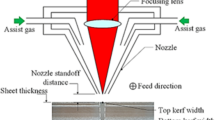Abstract
Stellite 6 is the most generally useful cobalt alloy, having excellent resistance to many forms of mechanical and chemical degradation over a wide temperature range. Therefore, in particular, their use in aerospace projects world wide has provided confidence leading to acceptance as prime material for aerospace vehicles in recent years. This paper outlines the effectiveness of the ultrasonic machining of stellite 6 in terms of tool wear rate of the tool used and the material removal rate of work piece produced. The optimum combination of various input factors as type of abrasive slurry, their size and concentration, nature of tool material and power rating of the machine for the ductile chip formation in the machining of stellite 6 has been determined by applying the Taguchi multi-objective optimization technique and F-test. The analysis of results has been done using the statistica 7.0 software and results obtained are validated by conducting the confirmation experiments. The study shows the considerable improvement in multiple S/N ratio as compared to initial cutting conditions.





Similar content being viewed by others
References
Sanchez AJ (2006) Study on gap variation in multi-stage planetary EDM. Int J Mach Tools Manuf 46:1598–1603
Wang H, Wu CL (2000) The mechanism of material removal in ultrasonic drilling of engg ceramics. Proc Inst Mech Eng 214:805–810
Hu P, Zang JM, Pei ZJ, Treadwell C (2002) Modeling of material removal rate in rotary ultrasonic machining: designed experiment. J Materi Process Technol 129:339–344
Roy RK (1990) A premier on the Taguchi method. Van Nostrand Reinhold, New York
Jiang BC, Black JT, Hool JN, Wu CM (1989) Determining robot process capability using Taguchi methods. Robot Comp Integr Manuf 6:55–66
Jiang BC, Black JT, Chen DW, Hool JN (1991) Taguchi based methodology for determining/optimizing robot process capability. IIE Transac 23:169–184
Rim WT, Jang HK, Kim KJ (1991) Dynamic performance improvement of an electrical discharge machine using an experimental model analysis. Int J Mach Tools Manuf 31:305–314
Tam SC, Loh NH, Miyazawa S (1989) Optimization of the ECM-abrasive polishing of mild steel using response surface methodology. J Mech Work Technol 19:109–117
Chanin MN, Kuei CH, Lin C (1990) Using Taguchi design, regression analysis and simulation to study maintenance float systems. Int J Prod Res 28:1939–1953
Kuei CH, Madu CN (1994) Sequential experimentation and multilevel Taguchi designs in simulation meta modeling of a maintenance float problem. Microelectron Reliab 34:831–843
Benton WC (1991) Statistical process control and the Taguchi method: a comparative evaluation. Int J Prod Res 29:1761–1770
Chao PY, Hwang YD (1995) The investigation of metal cutting experiments by using of Taguchi-based methodology. Proc NSCD Part A Phys Sci Eng 19:295–308
Forouraghi B (1999) On utility of inductive learning in multi-objective robust design, artificial intelligence for engineering design. Anal Manuf 13:27–36
Hunga YH, Haung ML, Chang CH (2006) Optimizing the controller IC for micro HDD process based on Taguchi method. Microelectron Reliab 46:1183–1188
Mohammadi T, Moheb A (2004) Separation of copper ions by electro dialysis using Taguchi experimental design. Desalination 169:21–31
Mertol A (2000) Application of the Taguchi method to chip scale package (CSP) design. IEEE Trans Adv Package 23:266–276
Lin TR (2002) Optimization technique for face milling stainless steel with multiple performance characteristic. Int J Adv Manuf Technol 19:330–335
Chang CW, Kuo CP (2007) Evaluation of surface roughness in laser assisted machining of aluminum oxide ceramics with Taguchi method. Int J Mach Tools Manu 47:141–147
Author information
Authors and Affiliations
Corresponding author
Rights and permissions
About this article
Cite this article
Kumar, V., Khamba, J.S. Parametric optimization of ultrasonic machining of co-based super alloy using the Taguchi multi-objective approach. Prod. Eng. Res. Devel. 3, 417 (2009). https://doi.org/10.1007/s11740-009-0189-6
Received:
Accepted:
Published:
DOI: https://doi.org/10.1007/s11740-009-0189-6




